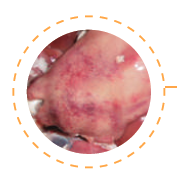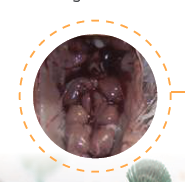These studies have shown that the consumption of viscera, especially liver, pose a higher risk than meat consumption. This is mainly due to the fact that most mycotoxins are metabolized and concentrated in the liver.
 15 Jun 2023
15 Jun 2023
Real hazards of mycotoxins in poultry and public health
FAO estimates that approximately 25% of the world’s food is significantly contaminated with mycotoxins, representing the real dangers of such contamination.
The term “mycotoxin” was coined in 1962 after an outbreak with high mortality in turkeys in England. The identified cause was the use of peanut meal from Brazil and Africa.
Introduction
Mycotoxins are secondary metabolites produced by heterogeneous fungi. When present in animal and human feed, they can act on the organism, impairing performance and causing pathological changes called mycotoxicosis.
These toxins can have a negative impact on animal production affecting health and productivity levels. Therefore, it is crucial to understand how different types of mycotoxins influence the health of birds in order to control and prevent economic losses.
Several epidemiological studies in humans have shown that the presence of mycotoxins in food, especially aflatoxins, can be quite harmful and may even be the cause of liver tumors.
Monitoring the genuine risks linked to the presence of these toxins in the food chain, particularly in milk, meat, and eggs, is crucial and falls under the collective responsibility of all stakeholders engaged in production, with health authorities playing a significant role.
Mycotoxins also affect various bird species with varying degrees of susceptibility.
![]()
Ducks, geese, and turkeys are more susceptible than broiler chickens.
It is also worth noting that the presence of mycotoxins in the early stages of bird life is always the most concerning.
According to recent studies, the presence of DON, for instance, can cause significant harm during the later phase of intestinal growth, specifically between 18 and 25 days, thereby impacting performance closer to the final fattening stage.
The most important mycotoxins are aflatoxins, ochratoxins, zearalenone, T-2 toxin, and fumonisins.
There are 6 main mycotoxin classes:
In poultry production, the main interactions and factors that can influence mycotoxicosis are:
Farm management, highlighting factors such as hygiene, humidity, and temperature;
While mycotoxins can elicit various effects, a shared characteristic among them is their ability to induce immunosuppression and compromise the overall immune system of birds.
Various recent studies confirm that broilers are sensitive to the presence of Fusarium spp. mycotoxins. and the presence of these mycotoxins at moderate levels negatively impacts appetite and hampers growth performance, particularly during the growth stage.
It is one of the main and most frequently found mycotoxin in animal production.
Clinical signs in birds:
Observed lesions:
Liver lesions are some of the most common. They are characterized by organ enlargement, friability, paleness, and marked fat infiltration.
Increased size of the spleen and kidneys.
Reduced size of the bursa of Fabricius and thymus.
Hemorrhages and petechiae in muscles (decreased coagulation factors and increased capillary fragility).
Carcinogenic and teratogenic changes. These can present themselves as acute or chronic conditions.

Bird liver with lesions associated with aflatoxicosis.
Clinical signs in birds:
Lesions observed in necropsy:
Enlarged kidneys, white to yellowish in color (with white foci of urate crystals)
Urate deposition on pericardial, perihepatic, peritoneal, and articular surfaces.
In surviving birds:

Bird kidneys with lesions consistent with the presence OTA.
The clinical signs in birds ingesting abnormal levels of trichothecenes, mainly T-2 toxin, are:
Oral lesions, decreased egg production, decreased shell quality, and hatchability rate are all observed in adult birds.
These lesions are highly characteristic:

Compatible lesions with T-2 toxin presence.
Due to the significance of corn as a fundamental ingredient in bird nutrition, particular emphasis is placed on fumonisins.
Most common clinical signs:
The observed lesions are more nonspecific:
The presence of these mycotoxins in birds can affect the reproductive system. Therefore, their importance is greater in adult birds, where secondary sexual characteristics are more evident and can cause thickening of the cloacal mucosa.
[register]
Despite the toxicological effects on production animals, the passage through the food chain, such as poultry meat, visceral consumption, and eggs, is a real danger and requires the utmost attention. The levels of mycotoxin residues in food for human consumption are described in European legislation. European legislation can be consulted for further details.
There are several scientifically published studies in reputable journals where eggs, meat, and offal from birds (laying hens and chickens) fed with high levels of mycotoxins are analyzed through various methods, assessing the potential danger to public health.
These studies have shown that the consumption of viscera, especially liver, pose a higher risk than meat consumption. This is mainly due to the fact that most mycotoxins are metabolized and concentrated in the liver.
The contamination of the food chain with mycotoxins poses a serious risk for public health. Affected individuals may experience acute aflatoxicosis, hepatocellular carcinoma, and hepatitis B, particularly in high-risk regions like Asia and Africa.
Humans can be exposed to a complex and variable combination of mycotoxins. After ingestion, the intestinal mucosa serves as the primary biological barrier that can be exposed to high concentrations of these toxins.
The high risk associated with long-term exposure to contaminated food requires the development and implementation of effective neutralization methods for mycotoxins.
Studies on zearalenone reveal that exposure to this mycotoxin can disrupt the body’s hormonal balance, potentially leading to numerous diseases associated with the reproductive system, such as: prostate, ovarian, cervical, or breast cancer.
However, a 2018 study conducted in China on highly contaminated food with this mycotoxin revealed that elevated levels of zearalenone in chicken tissues do not affect public health.
The T-2 toxin has also been extensively studied and found in food. Its neurotoxic effect has been identified, and we now know that the presence of T-2 toxin can have widespread implications for humans.
The maximum value allowed by the European Food Safety Authority (EFSA) for T-2 toxin in poultry feed is 0.25 mg/kg.
Recent research findings indicate that the estimated daily intake levels in various countries were consistently below the estimated total daily intake established by EFSA, implying that the EFSA reference value poses minimal risk.
Another interesting observation derived from these studies is that an increase in mycotoxin concentration in animal feed correlates with elevated levels of residues found in tissues, thereby amplifying the potential public health risk.
After removal of contaminated feed, residual levels in animals rapidly decline to acceptable values. Many of the maximum limits allowed for different mycotoxins are still unclear and need to be investigated, particularly regarding the actual hazards to public health, especially when present together.
New analysis methods are currently being researched. The issue associated with these methods is the amount of mycotoxins that exist, making them economically unsustainable in a demanding analytical program. Additionally, many of these methods are time-consuming, and many are specific to a particular mycotoxin.
Special attention has been attributed to aflatoxin M1, designated by the International Agency for Research on Cancer (IARC) as a predisposing factor for human cancer. Ochratoxin A (OTA), has been associated with kidney tumors, progressive nephropathies, inflammation, and oxidation.
As previously mentioned, the European Union has imposed limits on some of the most common mycotoxins, and several studies confirm that birds fed with feed containing amounts of mycotoxins within legal limits do not pose a significant risk to public health, as they are quickly metabolized by the birds.
In the case of suspected mycotoxicosis in birds, the following steps must be taken:
Bibliography available upon request
[/register]
Subscribe now to the technical magazine of animal nutrition
AUTHORS

Hybrid Rye Potential in Laying Hen Feed Rations
Gwendolyn Jones
A day in the life of phosphorus in pigs: Part I
Rafael Duran Giménez-Rico
Use of enzymes in diets for ruminants
Braulio de la Calle Campos
Minerals and Hoof Health in the Pregnant Sow
Juan Gabriel Espino
Impact of Oxidized Fats on Swine Reproduction and Offspring
Maria Alejandra Perez Alvarado